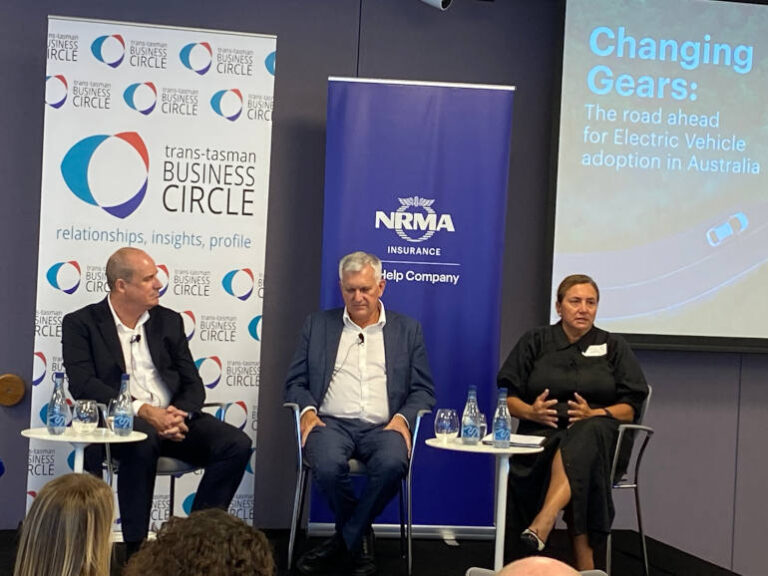The transition to electric vehicles (EVs) in Australia is underway, but significant challenges remain in accelerating adoption. A recent panel discussion at the Trans-Tasman Circle business lunch, titled “Changing Gears: The Road Ahead for EV Adoption in Australia,” featured key industry leaders exploring the opportunities and obstacles in the shift to electric mobility. The panel included Julie Batch, Chief Executive, NRMA Insurance; Rohan Lund, Group Chief Executive Officer, NRMA; and John Bright, General Manager, East Asia, Bosch Automotive Service Solutions, moderated by Gemma Acton, Director of News Operations at Seven Network.
Australia’s EV Landscape: Slow but Steady Growth
Julie Batch opened the discussion by acknowledging that while climate change used to be a topic of debate, the conversation has now moved to practical solutions like EV adoption. With 21 million vehicles on Australian roads, only 1.3% (approximately 270,000) are EVs. NRMA Insurance currently insures 25% of these vehicles and expects this figure to grow significantly, projecting that EVs will comprise 9% of its insured fleet by 2030.
Despite the growth in sales—from just 250 EVs sold in 2012 to 91,000 in 2024—many Australians remain anchored in outdated perceptions of EVs. Common concerns include battery life, range, and affordability, often based on technology from years past rather than current advancements.
Breaking Down Barriers: Infrastructure, Investment, and Consumer Confidence
A major hurdle to widespread EV adoption in Australia is charging infrastructure. Rohan Lund emphasised that range anxiety remains a real issue, particularly given Australia’s vast geography. The NRMA has been building EV charging stations for the past seven years, but progress is slow. Government policy uncertainty and a lack of investment are significant barriers, with Australia struggling to attract the capital required for large-scale EV infrastructure projects.
While metropolitan areas are seeing more charging stations, rural and regional networks remain underdeveloped, further limiting consumer confidence. Without the necessary infrastructure, many Australians hesitate to make the switch to electric vehicles.
Addressing Workforce Challenges in the EV Era
The shift to EVs also presents challenges for the automotive repair and service industry. John Bright highlighted the need to upskill mechanics and technicians, particularly as EVs come with complex, software-driven components. While hybrid vehicle technology has helped workshops gain some familiarity with high-voltage systems, there is still a severe skills shortage in the sector. Australia currently has around 38,000 unfilled skilled automotive positions, a gap that must be addressed to support EV adoption.
Bright stressed the need to rebrand automotive careers to attract young talent, moving beyond the traditional “mechanic” role to a more technology-focused profession. With EVs becoming increasingly sophisticated, future repair work will require expertise in diagnostics, software updates, and battery management.
The Role of Fleets in Driving EV Uptake
One area where EV adoption is accelerating is fleet purchases. Businesses are increasingly transitioning to electric and hybrid fleets, recognising the long-term cost savings and environmental benefits. NRMA and IAG, for example, have moved a significant portion of their fleets to EVs, though challenges remain in disaster-prone regions where hybrid vehicles may be more practical.
Fleets will likely be the key driver of mass EV adoption, with Lund predicting that large-scale fleet transitions in the next two years will help normalise EVs in the market. This shift will also fuel the growth of a second-hand EV market, an essential component in making EVs more affordable for everyday Australians.
Consumer Hesitation: Overcoming Misinformation and Cost Concerns
While the number of EV models available in Australia is increasing, consumers often struggle to navigate the options. Many OEMs (Original Equipment Manufacturers) still focus on high-end models, making EVs appear unaffordable to the average buyer. Additionally, the lack of a well-established second-hand EV market contributes to concerns about depreciation.
To address these challenges, Bright suggested that dealerships must play a more active role in educating consumers. Buyers need better guidance on:
- Choosing an EV that suits their lifestyle (e.g., city driving vs. regional travel).
- Understanding the total cost of ownership, including savings on fuel and maintenance.
- Simplifying technical jargon around battery range, charging speeds, and vehicle performance.
Policy, Investment, and the Road Ahead
The panelists agreed that policy stability and government incentives will play a crucial role in shaping Australia’s EV future. Lund pointed to global benchmarks—with Europe leading in policy support, infrastructure investment, and vehicle diversity—as examples for Australia to follow.
Julie Batch noted that, as the market matures, price points will become more competitive, and range anxiety will diminish. However, without clear and consistent government policies, Australia risks falling further behind other nations in the EV transition.
Conclusion: A Collaborative Effort for a Sustainable Future
The transition to EVs in Australia is inevitable, but the speed and success of this shift depend on investment in infrastructure, workforce training, fleet adoption, and consumer education. While challenges remain, the momentum is building. As Julie Batch stated, “Moving to an electronically powered fleet is a great thing for the environment. The debate is over—it’s now about action.”
To drive meaningful change, governments, businesses, and the automotive industry must work together to create an ecosystem where EVs are an attractive and practical option for all Australians.






